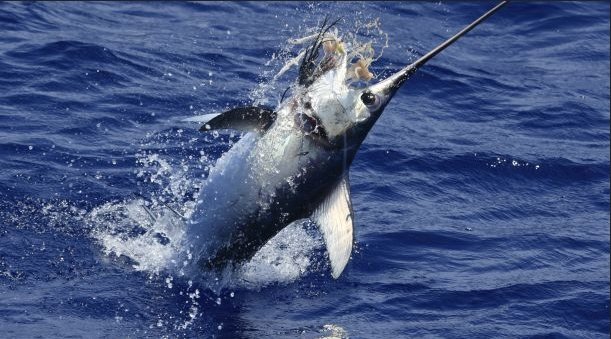
Imagine standing on a boat, feeling the cool breeze and watching the waves, and suddenly, a swordfish leaps out of the water. It’s a breathtaking sight, but it also makes you wonder about the safety of getting up close with these fish. Let’s dive into their world and explore the relationship between humans and swordfish, so you can understand what to expect if you ever find yourself in their watery domain.
What Are Swordfish?
Swordfish are large, predatory fish found in the Atlantic, Pacific, and Indian Oceans. They belong to the family Xiphiidae and can grow up to 10 feet long and weigh over 1,000 pounds. With their distinctive, elongated bills, which can reach nearly one-third of their body length, they are built for speed and power. Just picture them zipping through the ocean with the grace of a torpedo—truly impressive!
These fish are highly sought after for sport fishing and culinary purposes. In many cuisines around the world, swordfish steaks are a popular delicacy. Despite their size and strength, swordfish are vulnerable to overfishing, and their populations have declined in some areas. Understanding their behavior and habitat is key if we want to interact with them safely and sustainably.
Natural Behavior of Swordfish
Swordfish are mostly solitary creatures. They often swim alone or in small groups, making them less social than some other fish species. Their natural habitats range from the surface to deep ocean waters, which means they can be found swimming at various depths depending on temperature and time of day.
These fish are also known for their intriguing hunting techniques. They primarily feed on smaller fish and squid, using their sword-like bills to slash through schools of prey. This hunting method is fascinating because it showcases their agility and speed. But here’s the thing: when engaging with swordfish, it’s crucial to respect their space. They can be unpredictable, especially when provoked or threatened.
How Are Swordfish Interactions Typically Managed?
When it comes to interacting with swordfish, it’s important to approach these encounters responsibly. In sport fishing, many enthusiasts follow strict regulations to ensure the safety of both the fish and the fisherman. These guidelines often include catch-and-release practices, size limits, and seasonal restrictions to protect swordfish populations.
If you’re thinking about swimming with swordfish, like in certain eco-tourism activities, that typically means observing them from a distance. Most reputable tour operators ensure that interactions are safe and non-intrusive, allowing you to witness these incredible animals without causing them stress or harm. Engaging with the experts during these excursions can offer insighful information and safety tips.
Risks Involved in Human-Swordfish Interaction
While swordfish may seem alluring, there are risks to consider. First, their size and strength can be intimidating. A swordfish can injure a human with its bill if it feels threatened. Think about it: a fish that can easily overpower you is not something to take lightly.
Moreover, swordfish are known for their swift movements. This means they can be hard to predict during encounters, especially if you’re diving or snorkeling. Being in their territory and getting too close could lead to accidents. For your safety, always maintain a respectful distance and avoid any sudden movements that might startle them.
Best Practices for Interacting with Swordfish
If you ever find yourself in a situation where you can interact with swordfish, here are some best practices to follow:
- Keep a Safe Distance: Always observe swordfish from a respectful distance. This way, you won’t provoke them or put yourself in harm’s way.
- Follow Expert Guidance: If you’re with a tour or guide, listen to their instructions. They know how to navigate these encounters safely.
- Use Non-Intrusive Methods: Whether fishing or observing, use methods that are gentle and sustainable. Catch-and-release is a commonly recommended practice.
- Stay Calm: If a swordfish approaches you, remain calm and still. Sudden movements might alarm the fish and lead to unpredictable behavior.
Following these guidelines can greatly reduce risks and make your experience safer and more enjoyable.
What Should You Know About Swordfish Conservation?
Swordfish populations are affected by overfishing and habitat loss, which raises serious conservation concerns. Many countries have implemented management measures to protect swordfish stocks, but ongoing efforts are essential to ensure their survival.
Being aware of the conservation status of swordfish can influence your decision to interact with them. Here’s how you can make responsible choices:
- Choose Sustainable Seafood: If you’re eating swordfish, look for sustainably sourced options to support responsible fishing practices.
- Advocate for Conservation: Support organizations that work to protect marine life and their habitats. This ensures that future generations can enjoy the wonders of swordfish.
- Educate Others: Share what you learn about swordfish and marine conservation with friends and family. Spreading awareness can lead to more people making informed choices.
Your actions can contribute to the future of swordfish populations and their ecosystems.
Swordfish are remarkable creatures that spark curiosity and admiration. Interacting with them can be an unforgettable experience, but it’s essential to prioritize safety and conservation. Remember, they’re not just a spectacle; they’re an important part of our ocean’s ecosystem.
By following responsible practices and respecting their space, you can enjoy the beauty of swordfish while helping to ensure their survival. So next time you’re near the ocean, keep your eyes peeled for a glimpse of these extraordinary fish, but always approach them with wonder and respect. Who knows, you might just find yourself captivated by their grace and power, all while doing your part to protect them for the future.
